|
| |
After experiencing a long series of losing several individuals from heart attacks,
drunk driving accidents, suicides, knife and gun fights and other senseless acts of
violence in our town, I was beginning to get a case of "burnout" (common among
firefighters, emergency medical personnel and law enforcement officers). For me, this was
from not being able to make "the difference" I had been trained to do. After
all, that's what we're supposed to do, right? Well, one afternoon we were called out to
our local County Park where a boater had fallen overboard into Galveston Bay and couldn't
be found. We (our Department) do not own any watercraft, so we used our own personal boats
to join in the search with the Sheriff's Department Marine Division, the Kemah Police
Department's Marine Division, and a US Coast Guard launch and helicopter. After being out
on the water for several hours, our boat was running dangerously low on fuel (we were
already on our spare fuel tank) and it was starting to get dark. I had resigned to the
fact that all we were doing now was working on a body recovery, but I was not prepared to
handle what waited for me back on shore. After trailering our boat, we pulled up and
parked next to the Sheriff's tow vehicle to await word from the searchers still out on the
water. The family of the boater had arrived at the park and were naturally distraught. A
Sheriff's Deputy was talking with them when their marine unit returned to the dock. All
they were able to find was the boater's cap. A young boy, maybe 6 or 7 years old, spotted
the cap and went totally hysterical. His blood curdling screams of " My Daddy! . . .
I've lost my Daddy! . . . Please find my Daddy!" cut through my heart like an icy
cold knife. How do you tell a young child there is nothing else you can do to find or save
his daddy? That was just too much for me. The straw that broke the camels back, you might
say. I slowly became depressed (at the time I didn't know why). I became intolerant of
others, and a real bitch to my own family. I was losing interest in the fire department,
and I didn't care to participate in any activities with them. What I needed was some
distance and a distraction to get my mind off all the death I had witnessed. I needed to
somehow get a mark in the "WIN" column for a change. Strangely enough, it came
to me in the form of some wilting and dying plants at our local home improvement store.
Several months had past since the boating incident. Me and Debbie were at a Lowe's Home
Improvement store one day and we decided to take a trip through the garden section. Deb
was talking about getting some plants to put around the house to kind of spruce things up
a little, and she wanted to take a look at what they had to offer. While out in the
nursery section, I spotted a mark-down rack full of plants that looked like they hadn't
been cared for since they were first delivered to the store. This really bugged me for
some reason. Soon I was sorting through the plants, picking out any plant which showed any
sign of life still in it. I was bound and determined to save something - even if it was
just a few damn plants. I walked out of there with a cart full of 25 and 50 cent plants to
salvage. I attacked this project with the fervor of an uncontrollable obsession.
Unconsciously, I guess I was still looking for that mark in the win column, but what I got
back was a whole lot more. After babying and caring for these plants throughout the
winter, they came back and florished beautifully. The feelings I had when those first new
buds came out, the signs of new life, and the beautiful flowers that soon followed were
indescribable. I have found that this activity is relaxing (although not on the back
sometimes), and it gives me a chance to just think, unwind and get life back into proper
perspective. They allowed me to get back into action both in my life and my fire
department. Contrary to the advice of many noted gardening authorities, I still find
myself perusing the mark-down racks, looking for clearance items and those sickly little
plants that just need a little help.

| These Hibiscus plants were purchased about four years ago from a nursery
who was clearing out most all their stock to make room for their incoming Christmas
inventory. We kept them in their original containers for a couple of years then
transplanted them to the front of our house. Today they stand over 6' high (and that's
after pruning). We have several varieties of Hibiscus, ranging from solid red, red with
orange trim (pictured), orange, yellow, white and pink with a touch of white.
Unfortunately, two of the bushes were severly damaged last year when we were having a new
roof put on our house, but after some careful pruning they are now starting to make a
recovery and should be back up with the rest of the plants in a few years. |
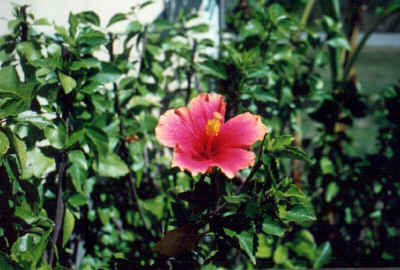
Signs of new life.
My first Hibiscus flower of Spring 2000. |

|
| Our "Cactus Garden" is a hodge-podge collection of desert /
prairie plants we've been gathering up over the years. Dominated by "Yucca"
bushes (Spanish Bayonets), the one in the background was just over three feet tall when it
was first planted three years ago. Today, it stands over 8' and has branched out into two
uprights. The smaller Yuccas which line the background of the bed (one of which is in the
right foreground) were all grown from root cuttings off a second Yucca, the boys dug up
from the field behind our house. Scattered throughout the bed are several Prickly Pear
cactus, which put on some beautiful bright yellow flowers in the early spring. The Aloe
Vera (front center) and the Century Plant (left) we brought back with us from our 1997
trip to Florida. The Century Plant came off a runner from a monster plant - about 15-20'
across - that grew next to Debbie's Mom's apartment. While we were down there the mother
plant had flowered on a "stem" that was about 8-10" in diameter near the
base, and stood close to 30' high. When I got this plant, it was about 4-6" across
and about as tall. Here, it stands just over 2' tall. I'm hoping it will eventually grow
as big as it's parent plant, although that will mean eventually having to dig up and move
the rest of the cactus garden. |
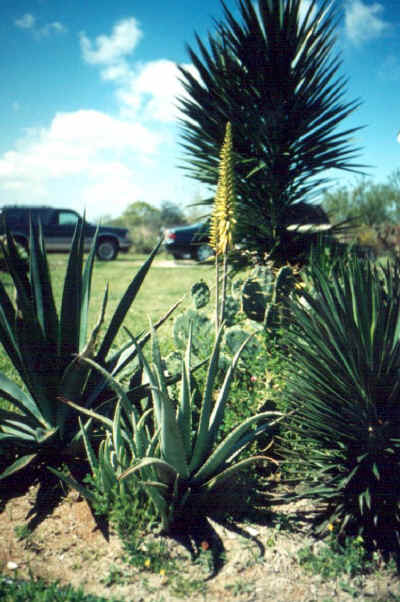
A surprise from my 3 year old Aloe Vera
(I didn't know they flowered!) |

|
| A buddy of mine who works for a neighboring city, called me one day and
asked if I wanted some plants. Sure, why not I replied - so he instructed me where to go
and the conditions under which I could have the plants. It turned out they were
demolishing their city's community center and everything was going to be bulldozed down.
If I wanted any of the plants from around the center I had to dig them up myself. Well it
didn't hurt to have a friend in the city's road department (who just happened to be
working on the demolition jobsite) who operates a backhoe! After seeing what they had
offered me I knew I had found a gold mine! I immediately called work and cashed in some
vacation time and spent the next week digging up and hauling away as many of the plants as
I could. The Sego Palm pictured here goes for about $500-$650 in local nurseries and I got
two of them! Once I got them dug up I found a total of 37 young sprouts attached to their
bases, which I've removed and have planted separately. In addition to these palms, I was
able to salvage 7 "Red Tip" Photinas, about 7' tall each, about 15 Ligustrum
bushes and about a dozen Nerium Oleander bushes. |
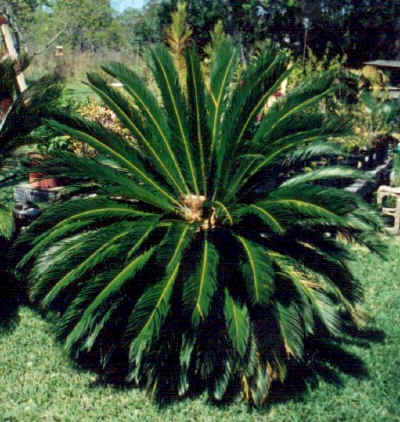
My latest salvation project - two 20 year old Sego Palms salvaged from a Community Center
demolition site. While it may not look like much here, this puppy stands about 4' tall, 6'
across, and weighs in around 150 lbs (bare root). They are currently potted up in 30
gallon pots made from a 60 gallon polyethylene drum. I hope to eventually have them grace
the side of a small water garden. |

|
| One of our garden projects we did this season. We put
in this bird bath in the back yard near the bird feeders (good place, huh) and planted
some Gladiolas, Day Lilies, and Calla Lillies around it. May 2000 |
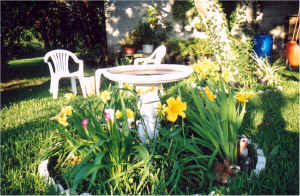 |

|
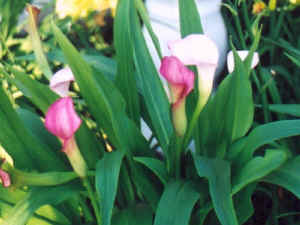 |
A close-up of our Calla Lillies. May 2000 |

|
| Among the many plants I bought with the Hibiscus' were
a few (4) Bananna Trees. They add a tropical touch to the yard, but are multiplying like
weeds. We started out with the four trees, and four years later we've now got close to 20,
and now one of the trees have sprouted it's first hand of banannas. July 2000 |
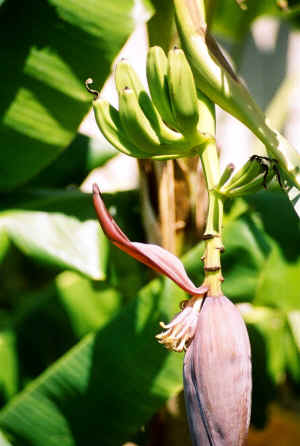 |

|
|
|
|
|
|
|
|
|
|
|
|
|
|
|
|
|
|
|
|
|
|
|
|
|
|
|
|
